You'll find comfort in these birdwatching groups designed for those with social anxiety. Quiet nature walks and small group expeditions offer peaceful observation. Virtual communities and online forums provide a safe space to connect from home. Solo birding meetups allow you to explore at your own pace. Mindfulness-based circles and sensory-friendly programs help manage anxiety. Photography-focused outings give you a concrete task to focus on. Guided silent tours minimize social pressure. Inclusive Audubon Society chapters offer specialized programs and mentorship. These groups provide various ways to enjoy birdwatching while feeling supported and at ease. Discover which option suits you best as you explore further.
Quiet Nature Walks
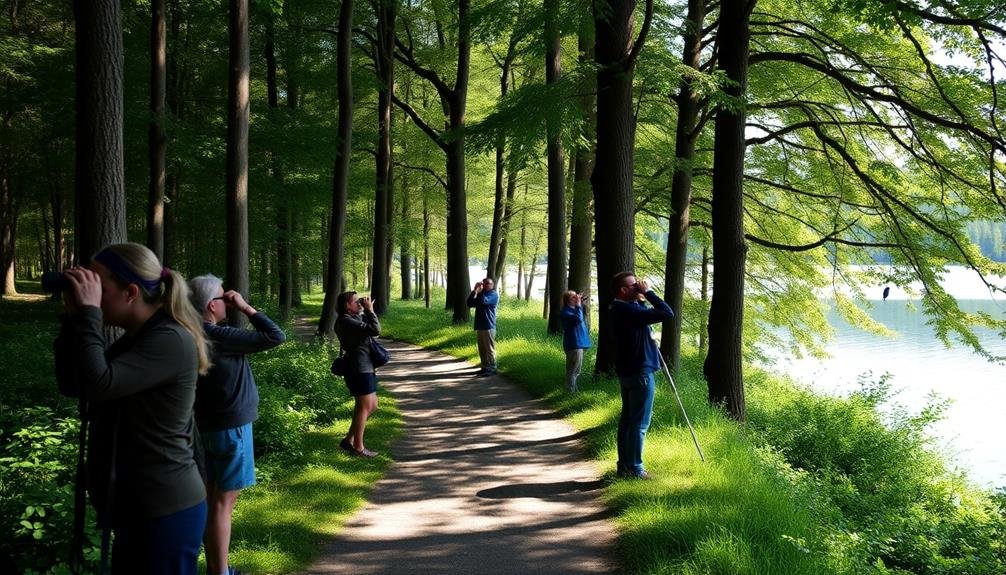
Birdsong fills the air as you step onto a secluded trail. You're part of a small group of birdwatchers, each seeking the tranquility of nature while gently easing into social interactions.
These quiet nature walks are perfect for those with social anxiety, offering a low-pressure environment to connect with others who share your passion. As you move through the forest, your guide uses hand signals to point out various bird species, minimizing verbal communication.
You'll find comfort in the shared silence, broken only by the occasional whisper of excitement when a rare bird is spotted. The focus on wildlife observation helps redirect anxious thoughts, allowing you to be present in the moment.
These walks often incorporate mindfulness techniques, encouraging you to tune into your senses and the natural world around you. You'll learn to identify birds by their calls, colors, and flight patterns, gradually building confidence in your skills.
Over time, you may find yourself more at ease with your fellow birdwatchers, forming connections based on shared experiences rather than forced conversation.
Small Group Expeditions
You'll find comfort in small group expeditions that limit participant numbers, creating a less overwhelming environment for those with social anxiety.
These intimate gatherings guarantee you receive personalized attention from experienced guides, allowing you to focus on the birds without feeling lost in a crowd.
Limited Participant Numbers
For those with social anxiety, small group expeditions offer a more comfortable birdwatching experience. Many organizations now limit their participant numbers to create a more intimate and less overwhelming environment. You'll find groups that cap their outings at 6-8 people, allowing for a quieter, less crowded atmosphere.
These limited-size groups provide several benefits. You'll have more opportunities to interact with the guide and ask questions without feeling overwhelmed. There's less pressure to socialize, as the smaller group dynamic often feels more natural and less forced.
You'll also have better access to prime viewing spots and shared equipment, like spotting scopes.
Look for birdwatching clubs or tour operators that specifically advertise small group sizes. Some even offer "quiet" tours designed for introverts or those with social anxiety. These outings focus more on the birdwatching experience and less on group interactions.
You might also consider joining a photography-focused birding group, as these tend to be smaller and offer built-in activities that can help ease social interactions.
Personalized Attention Guaranteed
Small group expeditions not only provide a more comfortable environment but also guarantee personalized attention for each participant. You'll find that guides can spend more time addressing your specific needs and interests when there are fewer people to manage. This personalized approach allows you to ask questions freely without feeling overwhelmed or embarrassed.
In these intimate settings, you'll have the opportunity to learn at your own pace. Guides can tailor their instruction to your skill level, whether you're a beginner or an experienced birder looking to refine your skills. They'll help you master bird identification techniques, improve your binocular use, and enhance your understanding of bird behaviors and habitats.
You'll also receive individualized feedback on your progress throughout the expedition. This one-on-one attention can boost your confidence and help you overcome any anxiety-related barriers to enjoying birdwatching.
Additionally, guides can provide tips on managing social anxiety in outdoor settings, making your experience more enjoyable and rewarding. With personalized attention, you're more likely to develop a lasting passion for birdwatching and feel comfortable participating in future group activities.
Less Overwhelming Environments
Three key factors make small group expeditions less overwhelming for those with social anxiety.
First, the smaller number of participants allows for a more intimate and manageable social setting. You'll find it easier to interact with a handful of people rather than a large crowd.
Second, the focus on birdwatching provides a shared interest and natural conversation starter, reducing the pressure to engage in small talk.
Lastly, the outdoor environment often has a calming effect, helping to ease anxiety symptoms. When you're surrounded by nature, you may feel more at ease and less self-conscious.
Small group expeditions typically offer:
- Limited group sizes, usually between 4-8 participants
- Quieter, more secluded birdwatching locations
- Flexible itineraries that can accommodate individual needs
These features create a less overwhelming atmosphere, allowing you to enjoy the birdwatching experience without feeling overwhelmed by social interactions.
You'll have the opportunity to gradually build connections with fellow birdwatchers at your own pace.
Virtual Birdwatching Communities
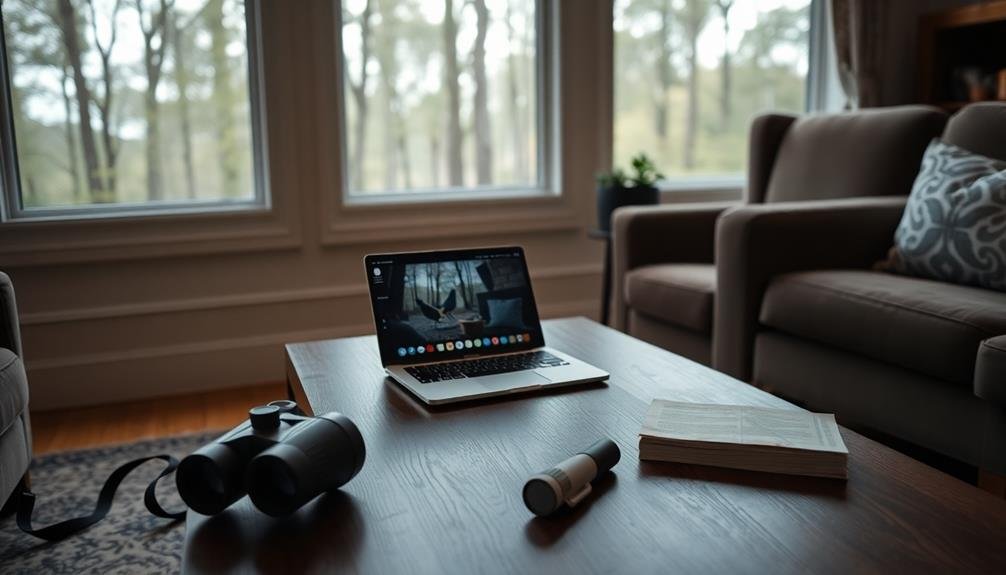
Virtual birdwatching communities offer a safe haven for enthusiasts with social anxiety. These online spaces allow you to connect with fellow birders without the pressure of face-to-face interactions. You'll find forums, social media groups, and dedicated websites where you can share sightings, ask questions, and learn from experienced birders.
Participate in virtual bird walks, where guides livestream their expeditions, allowing you to experience birdwatching from the comfort of your home. Many platforms offer bird identification challenges, quizzes, and photo contests to keep you engaged and improve your skills.
Consider joining these popular virtual birdwatching communities:
| Platform | Features |
|---|---|
| eBird | Global database, checklists |
| BirdForum | Discussion boards, expert advice |
| Birding Pal | Find local birding companions |
| iNaturalist | Species identification, community science |
| Merlin Bird ID | AI-powered bird identification app |
These online communities provide a stepping stone for gradually building confidence in your birdwatching skills. As you become more comfortable, you may feel ready to join in-person groups or attend local birding events. Remember, there's no pressure to shift to physical meetups – virtual birdwatching can be a fulfilling hobby on its own.
Solo Birding Meetups
For those ready to venture beyond virtual communities, solo birding meetups offer a gentle introduction to in-person birdwatching. These events cater to individuals who prefer a more solitary experience while still providing the opportunity to connect with like-minded enthusiasts.
You'll find that solo birding meetups are designed to minimize social pressure, allowing you to focus on the birds and nature around you.
When participating in a solo birding meetup, you'll typically:
- Arrive at a designated location and time
- Explore the area at your own pace, using provided maps or guides
- Reconvene at a specified time to share observations (optional)
These meetups strike a balance between independence and community, making them ideal for those with social anxiety.
You're free to interact as much or as little as you feel comfortable. By attending these events, you'll gradually build confidence in your birding skills and potentially form connections with others who share your passion.
Mindfulness-Based Birding Circles
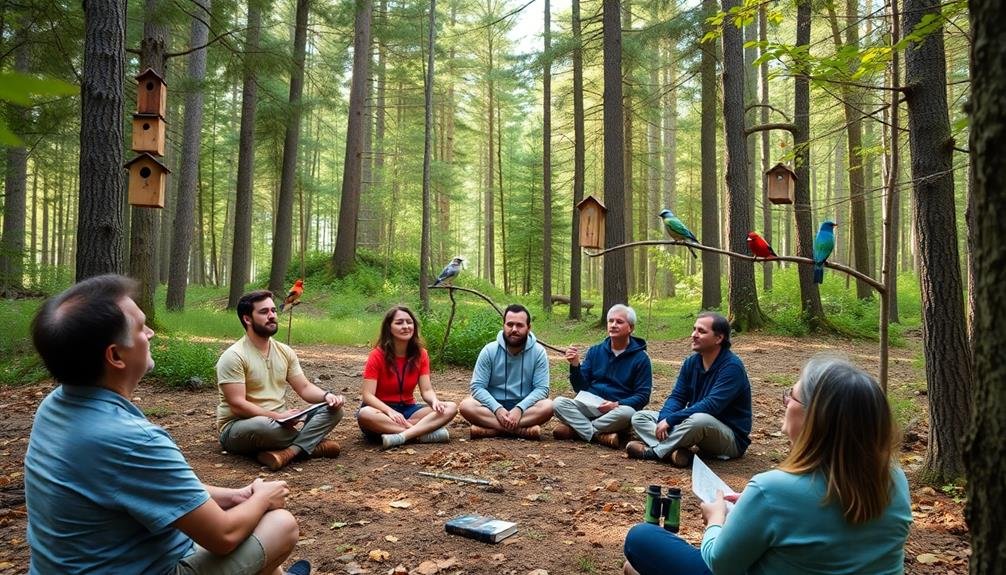
Tranquility meets birdwatching in mindfulness-based birding circles. These groups combine the calming practice of mindfulness with the joy of observing birds. You'll learn to be fully present in the moment, heightening your awareness of the natural world around you.
In these circles, you'll typically start with a brief guided meditation to center yourself. Then, you'll move into quiet observation, focusing on the sights, sounds, and movements of birds in their habitat. The emphasis is on experiencing rather than identifying, which can help ease anxiety about bird knowledge.
Here's what you might expect in a mindfulness-based birding session:
| Activity | Duration | Purpose |
|---|---|---|
| Guided meditation | 10 minutes | Centering and grounding |
| Silent observation | 20 minutes | Mindful bird watching |
| Gentle sharing | 15 minutes | Optional group reflection |
| Closing practice | 5 minutes | Gratitude and intention setting |
These groups often meet in peaceful natural settings, providing a serene environment for those with social anxiety. You'll find a supportive, non-judgmental atmosphere where you can connect with nature and others at your own pace. Remember, there's no pressure to socialize or speak if you're not comfortable.
Inclusive Audubon Society Chapters
Across the country, Audubon Society chapters are embracing inclusivity to create welcoming spaces for birdwatchers of all backgrounds and comfort levels.
These chapters recognize the importance of providing a supportive environment for individuals with social anxiety who share a passion for birding.
Many Audubon Society chapters now offer specialized programs and outings designed to accommodate those who may feel overwhelmed in large group settings.
You'll find:
- Small group excursions with limited participants
- Quiet zones during meetings and events
- Mentorship programs pairing experienced birders with newcomers
These inclusive chapters often provide resources and training for their members to better understand and support individuals with social anxiety.
They've implemented strategies like clear communication of event expectations, flexible participation options, and designated quiet areas during gatherings.
You can reach out to your local Audubon Society chapter to inquire about their inclusive initiatives.
Many chapters are open to feedback and suggestions, so don't hesitate to share your needs or concerns.
Sensory-Friendly Outdoor Programs
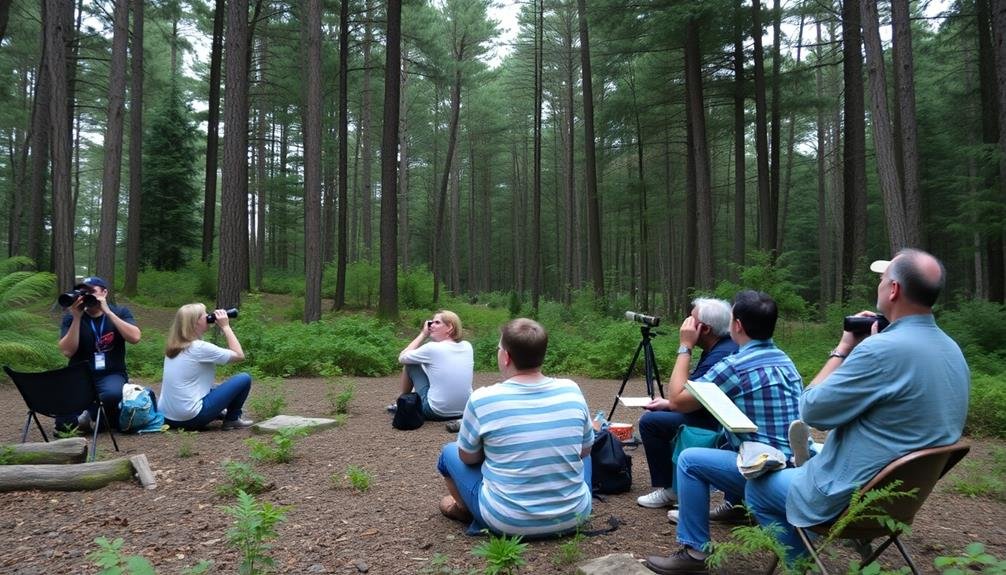
You'll find sensory-friendly outdoor programs focusing on quiet observation techniques that minimize auditory stimuli.
These programs typically feature small group sizes, allowing for more personalized attention and reduced social pressure.
They're often set in low-stimulation environments, such as secluded nature trails or dedicated bird blinds, to help manage anxiety triggers.
Quiet Observation Techniques
Quiet observation techniques form the backbone of sensory-friendly outdoor programs for birdwatchers with social anxiety.
These methods allow you to engage with nature while minimizing social interactions and sensory overload. You'll learn to use your senses effectively, focusing on subtle sounds and movements that indicate bird activity.
Practice these essential quiet observation techniques:
- Stationary watching: Find a comfortable spot and remain still for extended periods, allowing birds to become accustomed to your presence.
- Silent walking: Move slowly and deliberately through natural areas, avoiding sudden movements or noise that might startle wildlife.
- Mindful listening: Train your ears to distinguish between different bird calls and songs, enhancing your ability to locate and identify species.
Small Group Sizes
While quiet observation techniques are fundamental, the size of your birdwatching group can considerably impact your comfort level. Many organizations now offer small group experiences tailored for those with social anxiety. These intimate gatherings typically limit participants to 5-8 people, allowing for a more relaxed atmosphere and personalized attention.
You'll find that smaller groups provide several advantages:
| Benefits | Drawbacks |
|---|---|
| Less overwhelming | Limited social interaction |
| More individualized support | Fewer shared discoveries |
| Easier to maintain quiet | Potentially higher cost |
When selecting a group, consider your comfort level with social interactions. Some programs offer "silent walks," where conversation is minimal, focusing solely on birdwatching. Others incorporate brief, structured interactions to help you gradually build confidence.
Don't hesitate to reach out to group leaders beforehand to discuss your needs. Many are trained to accommodate various anxiety levels and can provide additional support or modifications. Remember, the goal is to enjoy nature and birdwatching at your own pace, so choose a group size that feels right for you.
Low-Stimulation Environments
For individuals with social anxiety, sensory overload can be a significant concern. Birdwatching groups that offer low-stimulation environments can provide a more comfortable experience for those who are easily overwhelmed.
These sensory-friendly outdoor programs focus on creating a calm atmosphere while still allowing participants to enjoy nature and observe birds.
When looking for a birdwatching group that prioritizes low-stimulation environments, you'll want to reflect on the following features:
- Quiet observation areas with minimal background noise
- Small, spread-out groups to reduce crowding and social pressure
- Flexible schedules that allow for breaks and personal space
These groups often choose locations away from busy urban areas, opting instead for secluded nature reserves or less-frequented parks.
They may also provide noise-canceling headphones or designated quiet zones for those who need a break from stimulation.
By incorporating these elements, sensory-friendly birdwatching groups create a more inclusive environment that accommodates the needs of individuals with social anxiety.
You'll find that these programs allow you to focus on the birds and nature around you without feeling overwhelmed by excessive sensory input or social expectations.
Photography-Focused Bird Outings
Focusing on photography during bird outings can provide a comforting buffer for those with social anxiety. When you're behind the camera, you'll have a concrete task to focus on, reducing the pressure to engage in small talk.
Many birdwatching groups now offer specialized photography-focused outings, catering to both novice and experienced photographers. These outings often move at a slower pace, allowing you to take your time setting up shots and observing birds through your lens.
You'll find that fellow photographers are often more interested in discussing camera settings and techniques than engaging in personal conversations. This shared interest can lead to natural, low-pressure interactions centered around your hobby.
Look for groups that offer photography workshops or classes as part of their outings. These structured activities can provide valuable learning opportunities while minimizing social expectations.
You might also find that carrying camera equipment gives you a sense of purpose and occupation during lulls in bird activity. Remember, it's perfectly acceptable to spend most of your time looking through your viewfinder rather than making eye contact with others.
Guided Silent Birding Tours
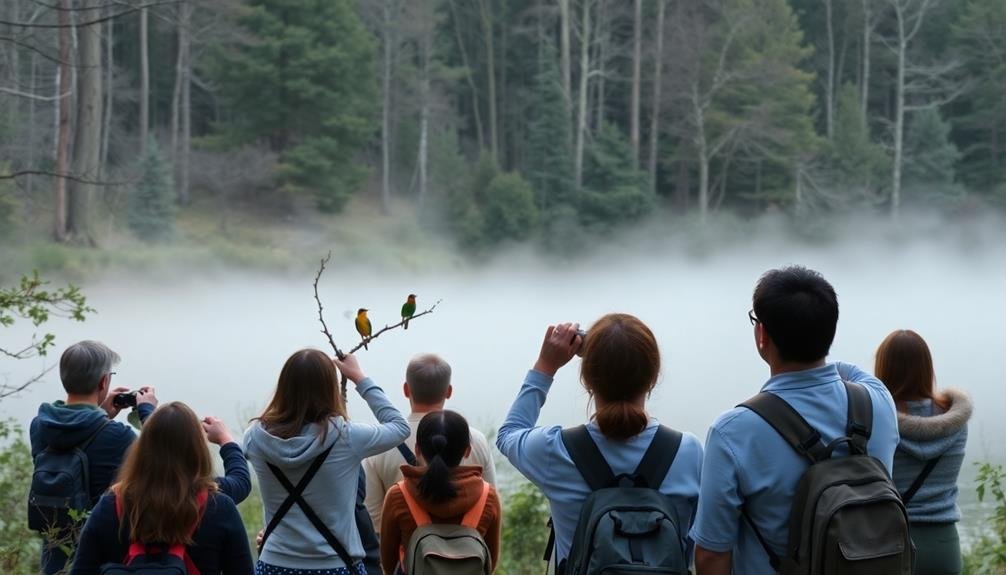
At the opposite end of the spectrum from chatty group outings, guided silent birding tours offer a unique experience for those with social anxiety.
These tours prioritize quiet observation and minimal social interaction, allowing you to focus solely on the birds and their natural habitats. You'll move through nature trails with a knowledgeable guide who communicates primarily through hand signals and written notes.
Silent birding tours provide several benefits for socially anxious birdwatchers:
- Reduced pressure to engage in small talk or social interactions
- Enhanced ability to concentrate on bird sightings and sounds
- A sense of shared experience without the need for verbal communication
You'll find that these tours often attract like-minded individuals who appreciate the tranquil atmosphere.
The guide will typically provide a pre-tour briefing on hand signals and expectations, ensuring everyone understands the silent protocol. Throughout the outing, you'll have opportunities to spot and identify various bird species while maintaining a peaceful environment.
Many participants report feeling more relaxed and present during silent tours, as they're able to immerse themselves fully in the birdwatching experience without social distractions.
If you're looking for a way to enjoy birdwatching while minimizing social anxiety, guided silent birding tours may be the perfect solution.
Online Birdwatching Forums
Online birdwatching forums offer a digital alternative for those who find in-person interactions challenging. These platforms allow you to connect with fellow bird enthusiasts from the comfort of your home, sharing experiences and knowledge without the pressure of face-to-face communication.
You'll find various forums catering to different interests within birdwatching. Some focus on specific regions, while others cover broader topics. Here's a comparison of popular online birdwatching forums:
| Forum Name | Focus Area | User-Friendliness |
|---|---|---|
| BirdForum | Global | High |
| eBird | Data-driven | Medium |
| Birding.com | North America | High |
When participating in these forums, you can:
- Share your bird sightings and photos
- Ask for help identifying birds
- Learn about local birdwatching hotspots
Remember to respect forum rules and etiquette. Start by introducing yourself and observing the community's dynamics before actively participating. As you become more comfortable, you may find yourself building meaningful connections with other birdwatchers who share your passion, all while managing your social anxiety in a controlled environment.
Frequently Asked Questions
How Can I Manage Panic Attacks During Group Birdwatching Activities?
You can manage panic attacks during group birdwatching by practicing deep breathing, focusing on the birds, using grounding techniques, and stepping away if needed. Don't hesitate to communicate your needs to the group leader or a trusted friend.
Are There Any Birdwatching Groups Specifically for Neurodivergent Individuals?
Yes, you'll find birdwatching groups for neurodivergent individuals. They're often organized by local autism or ADHD support organizations. You can also check online forums and social media platforms for specialized groups in your area.
What Adaptive Equipment Is Available for Birdwatchers With Physical Disabilities?
You'll find various adaptive tools for birdwatching with physical disabilities. These include wheelchair-accessible binoculars, one-handed spotting scopes, lightweight tripods, binocular harnesses, and smartphone apps for bird identification. Some groups also offer specialized equipment rentals for members.
How Do I Politely Decline Social Interactions While Still Participating in Group Outings?
You can politely decline social interactions by saying you're focusing on birdwatching. Use phrases like "I'd prefer to observe quietly" or "I'm here to enjoy nature." Don't feel obligated to explain further; most people will understand.
Are There Any Birdwatching Scholarships or Financial Assistance Programs for Low-Income Enthusiasts?
You'll find several options for financial assistance in birdwatching. Check local Audubon chapters for grants, explore online birding communities for scholarships, and look into equipment lending programs. Don't let cost deter you from pursuing your passion for birds!
In Summary
You've got plenty of options to enjoy birdwatching while managing your social anxiety. Whether you prefer quiet walks, small groups, or virtual communities, there's a way for you to connect with nature and fellow bird enthusiasts at your own pace. Don't let anxiety hold you back from this rewarding hobby. Try out different groups and approaches until you find what works best for you. Remember, it's about enjoying the birds and finding your comfort zone.





Leave a Reply